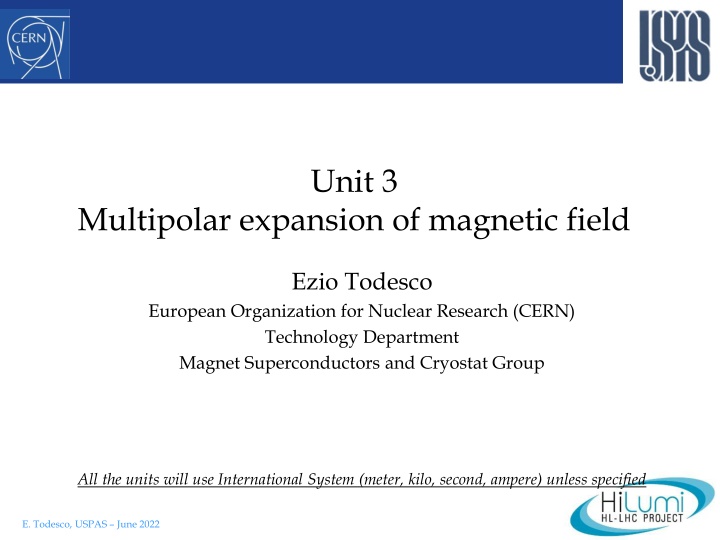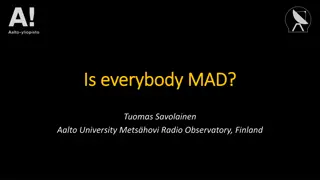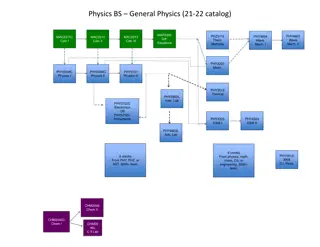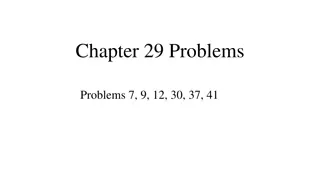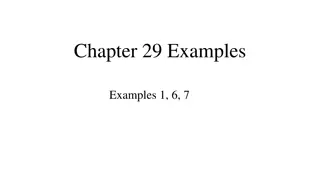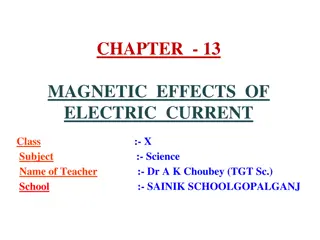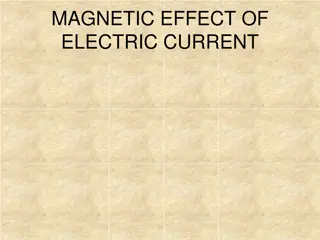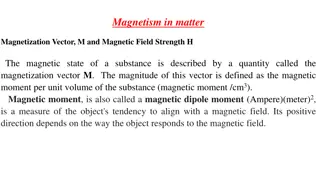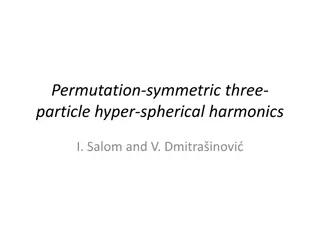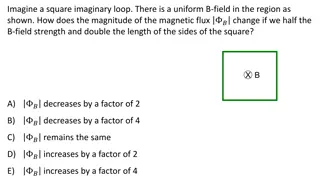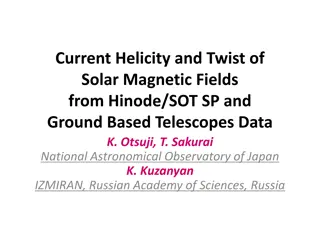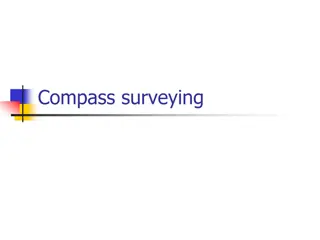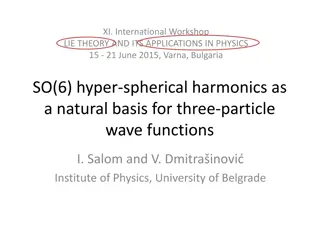Multipolar Expansion of Magnetic Field and Field Harmonics in Physics
This content delves into the concepts of field harmonics, Maxwell equations for magnetic field, complex numbers, and analytic functions in the context of magnetic field measurements. It explores the mathematical intricacies involved in understanding magnetic fields and the applications of these theories in practical scenarios. The discussion includes insights on the validity limits of field harmonics, the relevance of complex numbers in solving equations involving negative numbers, and the conditions for a function to be considered analytic.
Uploaded on Feb 25, 2025 | 1 Views
Download Presentation

Please find below an Image/Link to download the presentation.
The content on the website is provided AS IS for your information and personal use only. It may not be sold, licensed, or shared on other websites without obtaining consent from the author.If you encounter any issues during the download, it is possible that the publisher has removed the file from their server.
You are allowed to download the files provided on this website for personal or commercial use, subject to the condition that they are used lawfully. All files are the property of their respective owners.
The content on the website is provided AS IS for your information and personal use only. It may not be sold, licensed, or shared on other websites without obtaining consent from the author.
E N D
Presentation Transcript
Unit 3 Multipolar expansion of magnetic field Ezio Todesco European Organization for Nuclear Research (CERN) Technology Department Magnet Superconductors and Cryostat Group All the units will use International System (meter, kilo, second, ampere) unless specified E. Todesco, USPAS June 2022
CONTENTS Definition of field harmonics Field harmonics of a current line Validity limits of field harmonics Some applications of tough mathematics to magnetic field measurements Hints on beam dynamics requirements on field harmonics Unit 3 - 2 E. Todesco, USPAS June 2022
FIELD HARMONICS: MAXWELL EQUATIONS Maxwell equations for magnetic field + z y x B B B E y = + = = + x z 0 B B J 0 0 0 t In absence of charge and magnetized material (inside a magnet) x y z B B B B B B James Clerk Maxwell, Scottish (13 June 1831 5 November 1879) y y = = x x z z , , 0 B z y x Bz = If (constant longitudinal field), then + y x 0 z B B B B y = y 0 = x 0 x y x Remember: x and y perpendicular to the beam (transverse coordinates), z along the beam (s in previous unit) Unit 3 - 3 E. Todesco, USPAS June 2022
COMPLEX NUMBERS Complex numbers are defined to be able to find a solution to the square root of negative numbers This is an extension of real numbers The advantage is that every equation of nth degree has n solutions in the complex domain The trick is to define i= (-1) A complex number has two components z=a+ib Can be written also in the exponential form z= exp(i ) = (a2+b2) Imaginary part b z=a+ib Imaginary part z= exp(i ) a Real part Real part Unit 3 - 4 E. Todesco, USPAS June 2022
FIELD HARMONICS: ANALYTIC FUNCTIONS A complex function of complex variables is analytic if it coincides with its power series = n = n = 1 n ( ) f z C nz + = + 1 n ( , ) ( , ) ( ) ( , ) f x y if x y C x iy x y D x y n 1 1 on a domain D ! Note: not every combination of fx+ifyis analytic ! Note: domains are usually a painful part, we talk about it later A necessary and sufficient condition for (fx, fy) to have fx+ify analytic is that = f y f f y 0 x x y f y + = 0 x x Augustin Louis Cauchy French (August 21, 1789 May 23, 1857) called the Cauchy-Riemann conditions Unit 3 - 5 E. Todesco, USPAS June 2022
DEFINITION OF FIELD HARMONICS Bz If = f 0 f y = 0 x z B B x y y = 0 x f x y f y Maxwell gives + = 0 x y x B B y + = 0 x y x and therefore the function By+iBx is analytic = n 1 n ( ) ( , ) x y D + = + ( , ) ( , ) B x y iB x y C x iy y x n where Cn are complex coefficients 1 Georg Friedrich Bernhard Riemann, German (November 17, 1826 - July 20, 1866) Please note the analytic function is not Bx+iBy but By+iBx in other books you can find Bx-iBy , it is the same Unit 3 - 6 E. Todesco, USPAS June 2022
DEFINITION OF FIELD HARMONICS To describe the magnetic field we associate to each point of the space a vector For instance to store in a computer we need to create a matrix (grid in the space) and for every point of the grid we store two numbers y (Bx(x0,y0),By(x0,y0)) y0 x x0 Thanks to the multipole expansion, we just need a series of complex coefficient A matematician would say we reduce the description of a function from R2 to R2 to a (simple) series of complex coefficients Attention !! We lose something (the function outside D) (we will come back to this) Unit 3 - 7 E. Todesco, USPAS June 2022
DEFINITION OF FIELD HARMONICS n-1 ( ) Cnx+iy ( , ) x y D By(x,y)+iBx(x,y)= =C1+C2(x+iy)+... n=1 Each coefficient corresponds to a pure multipolar field A dipole A quadrupole [from P. Schmuser et al, pg. 50] A sextupole Magnets usually aim at generating a single multipole Dipole, quadrupole, sextupole, octupole, decapole, dodecapole Combined magnets: provide more components at the same time (for instance dipole and quadrupole) more common in low energy rings, resistive magnets one superconducting example: JPARC E. Todesco, USPAS June 2022 (KEK, Japan) Unit 3 - 8
DEFINITION OF FIELD HARMONICS n-1 ( ) Cnx+iy ( , ) x y D By(x,y)+iBx(x,y)= =C1+C2(x+iy)+... n=1 The field can be described by in infinite number of complex coefficients This means a double infinite number of real numbers We made a huge simplification in the description of the magnetic field But the story is not ended The series is converging quite rapidly so if you stop at order ten the precision is good enough only 20 numbers we will see this in this unit For the optimization of the layout of a magnet, there are symmetries that set to zero many of these multipoles An optimization problem (coil layout in blocks) involves only about 5 numbers ! Unit 3 - 9 E. Todesco, USPAS June 2022
DEFINITION OF FIELD HARMONICS 1 1 n n ( ) ( )( ) n n + = + = + + ( , ) ( , ) B x y iB x y C x iy B iA x iy y x n n n = = 1 1 The field harmonics are rewritten as 1 n + x iy n + = + 4 10 ( ) B iB B b ia 1 y x n n R = 1 ref We factorize the main component (B1 for dipoles, B2 for quadrupoles) We introduce a reference radius Rref to have dimensionless coefficients We factorize 10-4 since the deviations from ideal field in superconducting magnets for particle accelerators have to be 0.01% The coefficients bn, an are called normalized multipoles bn are the normal, an are the skew (adimensional) Unit 3 - 10 E. Todesco, USPAS June 2022
DEFINITION OF FIELD HARMONICS 1 n + x iy n + = + 4 10 ( ) B iB B b ia 1 y x n n R = 1 ref Reference radius is usually chosen as 2/3 of the aperture radius This is done to have numbers for the multipoles that are not too far from 1 Some wrong ideas about reference radius Wrong statement 1: the expansion is valid up to the reference radius The reference radius has no physical meaning, it is as choosing meters of mm We will come back on the validity limit Wrong statement 2: the expansion is done around the reference radius A power series is around a point, not around a circle. The expansion is around the origin y 40 - - Rref + + 0 r x - 40 0 40 + + - - - 40 Unit 3 - 11 E. Todesco, USPAS June 2022
CONTENTS Definition of field harmonics Field harmonics of a current line Validity limits of field harmonics Some applications of tough mathematics to magnetic field measurements Hints on beam dynamics requirements on field harmonics Unit 3 - 12 E. Todesco, USPAS June 2022
FIELD OF A CURRENT LINE Field given by a current line (Biot-Savart law) Differential form (international system) r Infinite current line A factor two is given by the atan integration F lix Savart, French (June 30, 1791-March 16, 1841) r Field in a centre of a circular loop, radius r Jean-Baptiste Biot, French (April 21, 1774 February 3, 1862) r Unit 3 - 13 E. Todesco, USPAS June 2022
ABOUT THE CONSTANT MU ZERO Field given by a loop prototype of a solenoid r About the constant It is terribly small = m/A This means that with 1 A at 1 m you get less than 1 T This is why to make few T you need MA turns F lix Savart, French (June 30, 1791-March 16, 1841) Jean-Baptiste Biot, French (April 21, 1774 February 3, 1862) Unit 3 - 14 E. Todesco, USPAS June 2022
FIELD OF A CURRENT LINE: COMPLEX NOTATION Field given by a current line (Biot-Savart law) Infinite current line y 40 z0=x0+iy0 Complex notation F lix Savart, French B=By+iBx (June 30, 1791-March 16, 1841) x 0 - 40 0 40 z=x+iy Using the relation - 40 We obtain the compact very useful notation Jean-Baptiste Biot, French (April 21, 1774 February 3, 1862) Unit 3 - 15 E. Todesco, USPAS June 2022
ANOTHER DISGRESSION ON TAYLOR SERIES In Unit 1 we saw that, for <1 one can write (1+e)a=1+ae+O(e2) This is an extremely useful equation Example: 1/(1+0.1)=1/1.1=0.90909 but using the approximation(1+0.1)- 1=1-0.1+O(0.01)=0.9 and I neglect something that is order of 0.01 Now for a=-1 the whole series can be written 1 Example = n = + + + + = 2 3 1 nt 1 ... t t t 1 t 1 1 1 1-1/2= 1/2=2 2 3 1-1/2=1+1 1 2+1 +1 +...=1+0.5+0.25+0.125+...=1.875+O(0.06) 2 2 Unit 3 - 16 E. Todesco, USPAS June 2022
FIELD HARMONICS OF A CURRENT LINE Field given by a current line (Biot-Savart law) y = + 40 z0=x0+iy0 ( ) ( ) ( ) B z B z iB z y x 1 I I B=By+iBx = = ( ) 0 0 B z z 2 ( ) 2 z z z x 0 - 40 0 40 1 0 0 z z=x+iy 0 using F lix Savart, French - 40 (June 30, 1791-March 16, 1841) 1 = n = + + + + = 2 3 1 nt 1 t 1 ... t t t !!! 1 t 1 we get 1 n 1 1 n n R + I I z x iy = n = n ref z = = ( ) 0 0 B z 2 2 z z z R Jean-Baptiste Biot, French (April 21, 1774 February 3, 1862) 1 1 0 0 0 0 ref Unit 3 - 17 E. Todesco, USPAS June 2022
FIELD HARMONICS OF A CURRENT LINE Now we can compute the multipoles of a current line at z0 1 n 1 1 n n R + I I z x iy = n = n + x iy 0z ref z = = ( ) 0 0 B z 2 2 z z z R 1 1 0 0 0 0 ref 1 n + x iy n + = + 4 10 ( ) B iB B b ia 1 y x n n R 1.6 = 1 ref 1.4 1.2 1 z I = Re 0 B 1 bn+ian 1 2 0.8 0 0.6 1 n R 0.4 4 10 I ref z + = 0 z b ia 0.2 n n 2 B 0 0 1 0 0 5 10 15 Multipole order n Unit 3 - 18 E. Todesco, USPAS June 2022
FIELD HARMONICS DECAY OF A CURRENT LINE Multipoles given by a current line decay with the order 10 1 n R 4 10 I 1 ref z + = 0 z b ia n n bn+ian 2 B 0.1 0 1 0 0.01 +nln I m0104 2pRrefB1 Rref z0 ( )=ln ln bn+ian 0.001 0 5 10 15 Multipole order n The slope of the decay is the logarithm of (Rref/|z0|) At each order, the multipole decreases by a factor Rref /|z0| The decay of the multipoles tells you the ratio Rref /|z0|, i.e. where is the coil w.r.t. the reference radius like a radar one can detect assembly errors in the magnet through slope of the decay of the anomalies of the magnetic field shape (we will come back to this) Unit 3 - 19 E. Todesco, USPAS June 2022
FIELD HARMONICS DECAY OF A CURRENT LINE Multipoles given by a current line decay with the order 10 1 n R 4 10 I 1 ref z + = 0 z b ia n n bn+ian 2 B 0.1 0 1 0 0.01 +nln I m0104 2pRrefB1 Rref z0 ( )=ln ln bn+ian 0.001 0 5 10 15 Multipole order n The semilog scale is the natural way to plot multipoles This is the point of view of Biot-Savart But usually specifications are on a linear scale In general, multipoles must stay below one or a fraction of units see later This explains why only low order multipoles, in general, are relevant Unit 3 - 20 E. Todesco, USPAS June 2022
CONTENTS Definition of field harmonics Field harmonics of a current line Validity limits of field harmonics Some applications of tough mathematics to magnetic field measurements Hints on beam dynamics requirements on field harmonics Unit 3 - 21 E. Todesco, USPAS June 2022
VALIDITY LIMITS OF FIELD HARMONICS When we expand a function in a power series we lose something y 40 1 = n 1 t = + + + + = 2 3 1 nt 1 ... t t t 1 t 1 Example 1. In t=1/2, the function is 1 = 1 x 0 = 2 - 40 0 40 1 / 1 2 / 1 2 and using the series one has - 40 2 3 1 1 1 + + + + = 5 . 0 + + + . 1 = + 1 ... 1 . 0 25 . 0 125 875 ... 2 2 2 not bad with 4 terms we compute the function within 7% Unit 3 - 22 E. Todesco, USPAS June 2022
VALIDITY LIMITS OF FIELD HARMONICS When we expand a function in a power series we lose something y 40 1 = n 1 t = + + + + = 2 3 1 nt 1 ... t t t 1 t 1 Ex. 2. In t=1, the function is infinite 1 1 x 0 - 40 0 40 = = 1 1 0 and using the series one has ( ) 1 ( ) 1 - 40 2 3 + + + + = + + + + 1 1 ... 1 1 1 1 ... which diverges this makes sense Unit 3 - 23 E. Todesco, USPAS June 2022
VALIDITY LIMITS OF FIELD HARMONICS When we expand a function in a power series we lose something y y 40 40 1 = n 1 t = + + + + = 2 3 1 nt 1 ... t t t 1 t 1 Ex. 3. In t=-1, the function is well defined 1 1 1 + 1 x x 0 0 - 40 - 40 0 40 40 = 0 2 BUT using the series one has ( ) 1 ) 1 ( 1 + + - 40 - 40 ( ) 2 3 + + = + + 1 ... 1 1 1 1 ... even if the function is well defined, the series does not work: we are outside the convergence radius Unit 3 - 24 E. Todesco, USPAS June 2022
A GLIMPSE ON DIVERGENT SERIES If we are very clever, we can resum a divergent series y 40 1 = n 1 t = + + + + = 2 3 1 nt 1 ... t t t 1 t 1 Ex. 4. In t=-2, the function is well defined 1 1+2=1 3 x 0 - 40 0 40 BUT using the series one has ( ) - 40 2+ -2 ( ) 3+...=1-2+4-8+... 1+(-2)+ -2 If I am able to recognize this, I can resum 1-2+4-8 + = 1/3 This happens if you made an expansion to solve a problem and you are using it outside the series validity limits there are several type of divergent series and ways to renormalize, remove singularities, etc - this is just one type Unit 3 - 25 E. Todesco, USPAS June 2022
VALIDITY LIMITS OF FIELD HARMONICS If we have a circular aperture, the field harmonics expansion relative to the center is valid within the aperture 40 60 - - - - + + + + 0 0 - 40 0 40 - 40 0 40 + + + + - - - - - 60 - 40 For other shapes, the expansion is valid over a circle that touches the closest current line Don t use multipoles to compute the field in the coil !! Unit 3 - 26 E. Todesco, USPAS June 2022
VALIDITY LIMITS OF FIELD HARMONICS Field harmonics in the heads Harmonic measurements are done with rotating coils of a given length (see unit 21) they give integral values over that length If the rotating coil extremes are in a region where the field does not vary with z, one can use the 2d harmonic expansion for the integral 2d field harmonics 2d field harmonics B (T) B (T) -1 -1 0 15 0 15 length (m) length (m) If the rotating coil extremes are in a region where the field vary with z, one cannot use the 2d harmonic expansion for the integral One has to use a more complicated expansion B (T) no 2d field harmonics -1 0 15 length (m) Unit 3 - 27 E. Todesco, USPAS June 2022
CONTENTS Definition of field harmonics Field harmonics of a current line Validity limits of field harmonics Some applications of tough mathematics to magnetic field measurements Hints on beam dynamics requirements on field harmonics Unit 3 - 28 E. Todesco, USPAS June 2022
FIRST APPLICATION: VERIFICATION OF A MEASUREMENT SYSTEM The decay of multipoles is a powerful tool to verify the consistency of a magnetic measurement Let us take a measure of a magnetic field of a magnet via rotating coils Let us assume we have N consecutive measurements along the magnet axis bn(k), an(k) k=1, 2, N We compute the standard deviation of each multipole and we plot in a semilog scale If the measurement is well done and reference radius is 2/3 of the aperture the slope is 2/3 This means that the stdev of every successive multipole is 2/3 the previous one Every two orders you reduce by a factor two 10 1 bn+ian 0.1 0.01 0.001 0 5 10 15 Multipole order n What is expected as multipole decay Unit 3 - 29 E. Todesco, USPAS June 2022
SECOND APPLICATION: VERIFICATION OF A MEASUREMENT SYSTEM and this is a real example from the HL_LHC triplet Not only we check that the measurement is ok but the place where the line starts getting horizontal is the precision of the measurement system here we have a precision of 10-4 units, that means 10-8 of the main field (0.01 ppm) Precision Decay of standard deviation of multipoles measured in different sections of MQXFB quadrupole (L. Fiscarelli, P. Rogacki) Unit 3 - 30 E. Todesco, USPAS June 2022
THIRD APPLICATION: FINDING ASSEMBLY ERRORS Another example: we have a localized assembly error We have four measurements, one of them is affected by the error We compute the difference between the anomaly (measurements 2) and the average of 1, 3, and 4 We put the result in semilog scale The slope multiplied by the reference radius will give the distance of the assembly error If error is far from the aperture, slope is larger (decay is more rapid, that means it will be visible only on low order multipoles 2d field harmonics 10 1 B (T) bn+ian 0.1 0.01 -1 0.001 0 15 length (m) 0 5 10 15 Multipole order n Unit 3 - 31 E. Todesco, USPAS June 2022
CONTENTS Definition of field harmonics Field harmonics of a current line Validity limits of field harmonics Some applications of tough mathematics to magnetic field measurements Hints on beam dynamics requirements on field harmonics Unit 3 - 32 E. Todesco, USPAS June 2022
BEAM DYNAMICS REQUIREMENTS Main component of the dipoles (field) This is ensuring the orbit along the ring Typically a absolute knowledge of the magnetic field within 0.1% A spread between magnets of the order of 0.1% A reproducibility of the order of 0.01% We will see that the tolerances needed for building superconducting magnets naturally guarantee these levels Cables are positioned within 0.05 mm, apertures of the order of 25 mm, this gives 0.2% error in field, and similar values for spread For reproducibility it is critical to cycle the magnets Unit 3 - 33 E. Todesco, USPAS June 2022
BEAM DYNAMICS REQUIREMENTS Main component of the quadrupoles (gradient) The tune has to be controlled within 0.001 Tune is proportional to quadrupole main component If the total tune is large (for instance 60 in the LHC) even 0.01% variation of quadrupole force is visible Corrector elements and feedback solve the problem magnets alone cannot reach this level In general a absolute knowledge of quadrupole main component within 0.2% is achievable, a spread of 0.1%, and a reproducibility of 0.01% Note that accelerators with larger number of cells (larger tune) become more difficult Unit 3 - 34 E. Todesco, USPAS June 2022
BEAM DYNAMICS REQUIREMENTS Sextupolar components Sextupole gives chromaticity to be controlled on a edge of a cliff (positive but smaller than 10, negative values make the beam unstable) Dipoles have sextupolar components that needs to be controlled within 0.1 units (normalized multipoles) Example: in the LHC 1 units of b3 in the dipoles give 40 chromaticity units so one need to know and control b3 within 0.05 units, This is within reach of measurement systems, and with proper precycling reproducibility can be guaranteed Unit 3 - 35 E. Todesco, USPAS June 2022
BEAM DYNAMICS REQUIREMENTS High order mutipoles Rule of thumb (just to give a zero order idea): field harmonics have to be of the order of 0.1 to 1 unit Higher order are ignored in beam dynamics codes (in LHC up to order 11 only) Note that spec is rather flat, but multipoles are decaying !! Therefore in principle higher orders cannot be a problem 1.6 1.4 1.2 1 bn+ian 0.8 0.6 0.4 0.2 0 0 5 10 15 Multipole order n Unit 3 - 36 E. Todesco, USPAS June 2022
SUMMARY We outlined the Maxwell equations for the magnetic field They give a large constraint on the shape of the magnetic field B B B E y = + + = = + x z 0 B B J 0 0 0 x y z t We have seen that for a long magnet we can express the transverse field inside the aperture with a series of multipoles 4 ( 10 = n 1 n + x iy + = + ) B iB B b ia 1 y x n n R 1 ref Compact way of representing the field Biot-Savart: multipoles decay with multipole order as a power law Attention !! Validity limits and convergence domains Unit 3 - 37 E. Todesco, USPAS June 2022
SUMMARY We have seen how magnetic field is generated by a current line r r We have seen that is terribly small, making our work very challenging Unit 3 - 38 E. Todesco, USPAS June 2022
SUMMARY We have computed the multipoles of a current line r Using complex numbers it is quite fast as long as you know that in a certain region (inside the magnet aperture, far from current lines) 1 = n = + + + + = 2 3 1 nt 1 ... t t t 1 t 1 Unit 3 - 39 E. Todesco, USPAS June 2022
SUMMARY We have computed the multipoles of a current line r Multipoles of a current line decay as a power law 1 n R 4 10 I ref z + = 0 z b ia n n 2 B 0 1 0 Therefore: Increasing order they become so small that you can neglect them and stop the computation (order 10 to 15) Magnet specification are until order 10-15 Magnet optimization can stop at order 10-15 The measurement of field anomalies tell you where is the problem (the distance, the angle is more complicated) Unit 3 - 40 E. Todesco, USPAS June 2022
COMING SOON Coming soon It is useful to have magnets that provide pure field harmonics How to build a pure field harmonic (dipole, quadrupole ) [pure enough for the beam ] with a cable ? Which field/gradient can be obtained ? Unit 3 - 41 E. Todesco, USPAS June 2022
REFERENCES On field harmonics A. Jain, Basic theory of magnets , CERN 98-05 (1998) 1-26 Classes given by A. Jain at USPAS P. Schmuser, Ch. 4 On convergence domains of analytic functions Hardy, Divergent series , first chapter (don t go further) On the field model A.A.V.V. LHC Design Report , CERN 2004-003 (2004) pp. 164-168. N. Sammut, et al. Mathematical formulation to predict the harmonics of the superconducting Large Hadron Collider magnets Phys. Rev. ST Accel. Beams 9 (2006) 012402. Unit 3 - 42 E. Todesco, USPAS June 2022
ACKOWLEDGEMENTS A. Jain for discussions about reference radius, multipoles in heads, vector potential S. Russenschuck for discussions about vector potential G. Turchetti for teaching me analytic functions and divergent series, and other complicated subjects in a simple way www.wikipedia.org for most of the pictures Unit 3 - 43 E. Todesco, USPAS June 2022
DEFINITION OF FIELD HARMONICS Vector potential Since one can always define a vector potential Asuch that 0 = B A= B The vector potential is not unique (gauge invariance): if we add the gradient of any scalar function, it still satisfies A = ' + A f = + = = ' A A f A B Scalar potential In the regions free of charge and magnetic material Therefore in this case one can also define a scalar potential (such as for gravity) B g = = 0 B A+ ig One can prove that is an analytic function in a region free of charge and magnetic material Unit 3 - 44 E. Todesco, USPAS June 2022
FIELD HARMONICS OF A CURRENT LINE Field given by a current line (Biot-Savart law) vector potential formalism y 40 z0=x0+iy0 A A 1 = z = B z B B=By+iBx r r r x 0 - 40 0 40 z=x+iy + 2 0 2 2 cos( ) I I R 0 0 = = 0 0 ( , ) ln ln Az 2 2 0 0 - 40 and polar coordinates formalism y 40 z0= 0exp(i 0) 1 n I B ( ) = n = 0 sin B n x 0 0 r - 40 0 40 2 1 0 0 z= exp(i ) 1 n I ( ) = n = 0 cos B n 0 2 1 0 0 - 40 Unit 3 - 45 E. Todesco, USPAS June 2022
FIELD HARMONICS: LINEARITY 40 40 40 c'n+c''n =C'n+C''n C'n C''n c'n c''n - - - - + + + + 0 0 0 - 40 0 40 - 40 0 40 - 40 0 40 + + + + - - - - - 40 - 40 - 40 Linearity of coefficients (very important) Non-normalized coefficients are additive Normalized coefficients are not additive C c = + ' ' ' n ' ' ' n C C C C = + = + ' n ' ' n c c n n n n + ' ' ' 1 ' ' ' 1 B B B B B 1 1 1 Normalization gives handy (and physical) quantities, but some drawbacks pay attention !! Unit 3 - 46 E. Todesco, USPAS June 2022
